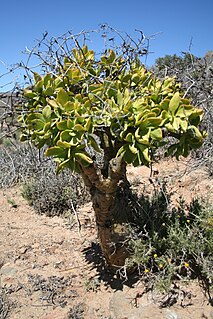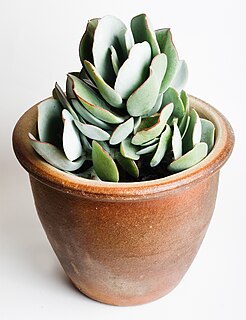
The Crassulaceae, also known as the stonecrop family or the orpine family, are a diverse family of dicotyledon flowering plants characterized by succulent leaves and a unique form of photosynthesis, known as Crassulacean acid metabolism (CAM). Flowers generally have five floral parts. Crassulaceae are usually herbaceous but there are some subshrubs, and relatively few treelike or aquatic plants. Crassulaceae are a medium size monophyletic family in the core eudicots, among the order Saxifragales, whose diversity has made infrafamilial classification very difficult. The family includes approximately 1,400 species and 34–35 genera, depending on the circumscription of the genus Sedum, and distributed over three subfamilies. Members of the Crassulaceae are found worldwide, but mostly in the Northern Hemisphere and southern Africa, typically in dry and/or cold areas where water may be scarce, although a few are aquatic.
A storage organ is a part of a plant specifically modified for storage of energy (generally in the form of carbohydrates) or water. Storage organs often grow underground, where they are better protected from attack by herbivores. Plants that have an underground storage organ are called geophytes in the Raunkiær plant life-form classification system. Storage organs often, but not always, act as perennating organs which enable plants to survive adverse conditions.

Dudleya is a genus of succulent perennial plants, consisting of about 45 species in southwestern North America.

A seedling is a young sporophyte developing out of a plant embryo from a seed. Seedling development starts with germination of the seed. A typical young seedling consists of three main parts: the radicle, the hypocotyl, and the cotyledons. The two classes of flowering plants (angiosperms) are distinguished by their numbers of seed leaves: monocotyledons (monocots) have one blade-shaped cotyledon, whereas dicotyledons (dicots) possess two round cotyledons. Gymnosperms are more varied. For example, pine seedlings have up to eight cotyledons. The seedlings of some flowering plants have no cotyledons at all. These are said to be acotyledons.

Pennywort is a common name given to several different plants around the world. In general they have round leaves and a low-growing habit. Pennywort may refer to:

Portulaca grandiflora is a succulent flowering plant in the family Portulacaceae, native to Argentina, southern Brazil, and Uruguay and often cultivated in gardens. It has many common names, including rose moss, eleven o'clock, Mexican rose, moss rose, sun rose, rock rose, and moss-rose purslane.

Cotyledon is a genus of succulent plants in the family Crassulaceae. Mostly from Southern Africa, they also occur throughout the drier parts of Africa as far north as the Arabian peninsula.

Cotyledon orbiculata, commonly known as pig's ear or round-leafed navel-wort, is a South African succulent plant belonging to the genus Cotyledon.

Saxifraga cotyledon, the pyramidal saxifrage, occurs in the mountains of Europe and has rosettes about 20 centimetres (8 in) across of tongue-shaped leaves, beaded but not toothed. In May or June the tall panicles of white flowers, branched and pyramidal in outline, may reach 60 cm (24 in). It is one of Norway's two national flowers. Its relationship to the "silver saxifrages" remains to be resolved to full satisfaction.
Glaucous is used to describe the pale grey or bluish-green appearance of the surfaces of some plants, as well as in the names of birds, such as the glaucous gull, glaucous-winged gull, glaucous macaw, and glaucous tanager.

Tylecodon is a genus of succulent plants in the family Crassulaceae, native to southern Africa.

Dudleya pulverulenta is a succulent plant known by the common names chalk lettuce, chalk dudleya, and chalk liveforever.

In botany, succulent plants, also known as succulents, are plants with parts that are thickened, fleshy, and engorged, usually to retain water in arid climates or soil conditions. It is a characteristic that is not used scientifically for the definition of most families and genera of plants because it often can be used as an accurate characteristic only at the single species level. The word succulent comes from the Latin word sucus, meaning 'juice', or 'sap'. Succulent plants may store water in various structures, such as leaves and stems. Some definitions also include roots, thus geophytes that survive unfavorable periods by dying back to underground storage organs may be regarded as succulents. In horticultural use, the term succulent is sometimes used in a way that excludes plants that botanists would regard as succulents, such as cacti. Succulents are often grown as ornamental plants because of their striking and unusual appearance, as well as their ability to thrive with relatively minimal care.

Cotyledon tomentosa is a species of flowering plant in the family Crassulaceae, native to South Africa. It is a succulent evergreen shrub with large chunky ovate fuzzy green leaves. Its autonymous subspecies is known as the bear's paw because of the prominent "teeth" at the tips of its leaves. It forms large orange bell-shaped flowers in spring. In its native habitat, the Little Karoo region of South Africa, cotyledons usually grow in rocky quartz fields where they have excellent drainage provided by very porous soil.

Crassula arborescens, the silver jade plant, silver dollar plant, beestebul, Chinese jade, money plant, or money tree, is a species of succulent plant in the family Crassulaceae. It is an endemic plant of the Western Cape, South Africa. It is a 2 to 4 ft succulent shrub. It has round gray "Silver Dollar" leaves. It blooms in winter, with white to pink flowers. It is cultivated as an ornamental plant for use in drought tolerant and succulent gardens, and in container gardens. It is also suitable for growing indoors as a houseplant.

Adromischus cristatus is a species of succulents from the family Crassulaceae, endemic to the eastern cape of South Africa. It is a perennial with short erect branches 20–50 mm long covered with fine aerial roots. Leaves are green to gray-green, with undulating margin, and generally measuring 20–40 × 5–13 mm. During the springtime, it sends up long narrow stalks for its flowers, which are tubular in shape and white in color with hints of red. Common names for this plant include "Key Lime Pie" and "Crinkle Leaf Plant."

Dudleya gnoma is a rare species of succulent plant in the stonecrop family known by the common names munchkin liveforever and munchkin dudleya. It is endemic to Santa Rosa Island, one of the Channel Islands of California, where it is known from one single population containing about 3200 plants. The population was discovered in the 1950s and assumed to be a relative of Dudleya greenei, a plant also occurring on the island which is similar but larger and contains the same number of chromosomes. The plant was not described to science until 1997. The population is protected from nearby grazing cattle by a fence. It still faces threats from deer, which can get past the fence, a limited gene pool, and the fact that a single severe event such as a drought, could eliminate the single population. Though rare in the wild, this dudleya is kept in cultivation by gardeners and enthusiasts of succulents, and a cultivar called 'White Sprite' is popular.

Acacia sulcata is a shrub of the genus Acacia and the subgenus Plurinerves that is endemic to an area of south western Australia.

Adromischus cooperi is a species of succulent plant from the family Crassulaceae. The genus name Adromischus comes from ancient Greek adros and mischos, and the species name from James Graham Cooper, an American naturalist and surgeon. The plant is endemic to the Eastern Cape of South Africa.

Mangaves are plants formerly given the nothogenus name × Mangave. They are derived from hybridizing species in the genus Agave and the former genus Manfreda. Manfreda is now included in Agave, so the scientific name is obsolete. Mangaves are often employed as ornamental plants in dry environments, as they possess traits of durability found in both parents. Around 30–40 cultivars were available as of 2020.

















